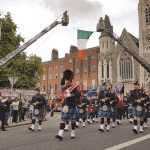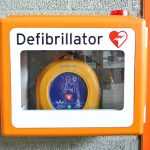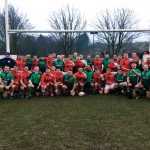Retired Station Officer Greg Matthews spoke about his career in Dublin Fire Brigade and his passion for street photography.
Retired Station Officer Greg Matthews has undoubtedly led an interesting and varied life. Born in 1961, the middle child in a family of five, he grew up in Ballyfermot and followed a path as a motor mechanic before pursuing his childhood dream of becoming a firefighter. Now that he’s retired, he spends his time pursuing several hobbies, among them street photography.
“The fire brigade was something that I had always longed to get into, something I thought would be a great job to do,” he explains. Greg was one of 42 firefighters in Class 1/1985, the first class to experience training in the then brand-new O’Brien Training Institute in Marino, which he describes as a ‘new dawn’ for Dublin Fire Brigade. Over the following 25 years he would work in every fire station across the job on A, B and C watch, and earn promotion first to sub officer and then station officer, the latter something he wanted to achieve since his first day. “To become a station officer was my ultimate goal – I didn’t really bother going for promotion after that point,” he explains with a laugh. “I was happy to reach that point.”
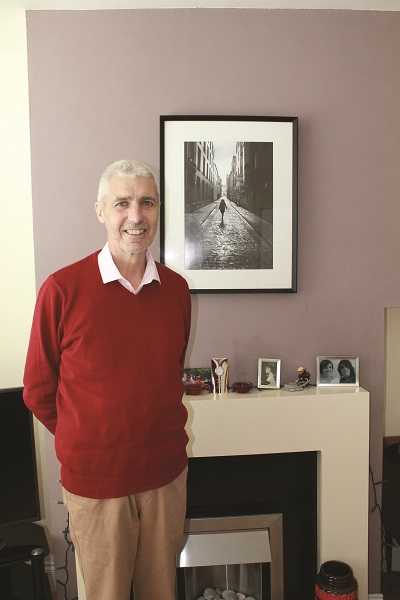
Greg Matthews
As we chat, Greg reminisces about a fulfilling career that encompassed a variety of strands. He recalls working in the ISO section at a time when DFB was striving to achieve the quality mark for its fire and ambulance services (something that had never been achieved before); earning a Guinness World Record as part of the team that beat the Germans’ distance in pushing a pump for 24 hours; and coming full circle as he returned to the OBI to mould several classes of recruits (he was also chosen as one of the brigade’s first swiftwater rescue instructors, a clear source of pride). “I completed two batches of recruit training, back-to-back, which is very difficult to do as an instructor. Training recruits is probably one of the most challenging things you can do but it is also one of the most rewarding – you are given seven guys fresh in off the street and you have to turn them into firefighters six months later,” he says. “It’s great to see recruits who I trained are now sub officers and station officers and they’re training recruits. I get a great kick out of that. There can’t be anything better than to think ‘There’s a guy that I trained and he’s reached a very high standard’.”
NEW ADVENTURES
After a busy career, Greg retired from DFB in 2010 on medical grounds, having developed a problem with one of his hips from running marathons. At the time, he explains, he was relatively happy to leave, feeling that he had made a significant contribution to the brigade over those years and feeling ready to explore other avenues of interest with his newfound free time. His first port of call was yachting and he earned a licence as a day skipper following a number of sailing courses. Next up – photography.
It was something that had lingered in his mind since he was a child – his father would bring home The Irish Press and Greg would comb the pages examining every detail of renowned photographer Austin Finn’s black and white photos of ordinary Dubliners going about their daily lives, even cutting them out for inclusion in a treasured scrapbook. Over the proceeding decades Greg would take photos now and then – perhaps on holiday – and people would comment on how they were a cut above the norm. Curious as to what separated his creations from others, he decided to do a photography course with Dublin Camera Club (where he met his partner Trudy). Though he struggled with the technical side of photography – exposition, shutter speed, focus and more – it gave him the freedom to create better images and bring his mind’s eye to life. Clearly he’s got a flair for it, having been named Irish Street Photographer of the Year in 2015 (as well as winning Street Photograph of the Year), with an exhibition of his photos held in Filmbase in Temple Bar that same year in memory of his late father. His increasing profile has also resulted in numerous invitations to speak at camera clubs around the country, sharing the lessons he has learned behind the camera and on the streets.
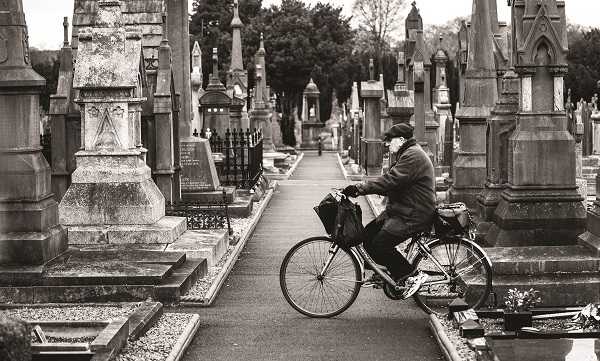
Shot for the most part in black and white, Greg’s photos tell a story, capturing intimate moments in time that might otherwise go unnoticed – a family enjoying a picnic on the beach in Bray, an elderly couple making their way over Dublin’s Ha’Penny Bridge, a man cycling through Glasnevin Cemetery. His style is quite artistic with many of his photos reminiscent of a painting; candid images of ordinary life inspired not only by Austin Finn but also Henri Cartier-Bresson, considered a master of street photography. Greg is reluctant to pigeonhole his work into any one category; instead he follows a few simple rules that guide the sights on his lens.
“Though I call myself a street photographer, it’s very hard to define what street photography is. For me, my photography is capturing people going about their daily lives,” he explains. “The person doesn’t know that their photograph is being taken. There has to be some point of interest in the image, there has to be something happening. A lot of people… they just think it’s photographs of people walking on the street and for me it’s not that.” Greg’s photos are bolstered by the fact that his subjects are unaware they are being photographed, displaying real emotions rather than a hastily assembled smile. A lot of his shooting is done from the hip, pointing and clicking the shutter through a café window or while stopped in the middle of a footpath. In the first few years the loud click from his Canon 5D Mark II would give the game away, so he took to coughing while he pressed the shutter to mask the sound, or would wait until a bus passed by on the road. He eventually opted for a Fuji X-T1, a much quieter, more discreet option that allows him to blend in a bit better with the crowds.
“As soon as you hit the shutter they look and they know – the moment is lost,” he says. “A lot of the time when I’m out doing my street photography I try to blend in and look like a tourist. If I’m walking down Moore Street and the dealers are looking at me I just look back at them. I find if you’re trying to be too discreet people are wondering what you’re at.”
Patience is the name of the game for Greg, who spends hours on the streets of Dublin observing life as it passes by and waiting for the right shot to enter his frame. Take Temple Bar Lady, his award-winning photo of a solitary woman walking along an empty laneway in Temple Bar. Having found the location, Greg repeatedly returned in search of the perfect canvas free from crowds, delivery vans or dustbins awaiting collection. A bit of luck, too, has its role to play from time to time. Having lined up a candid shot of one of Dublin’s characters, Greg surreptitiously pressed the shutter just as the man yawned. The result is a fantastic image of life’s mundanity – the ‘open’ sign in the background complementing the open-mouthed focus. “You still have to be there to get it,” he adds.
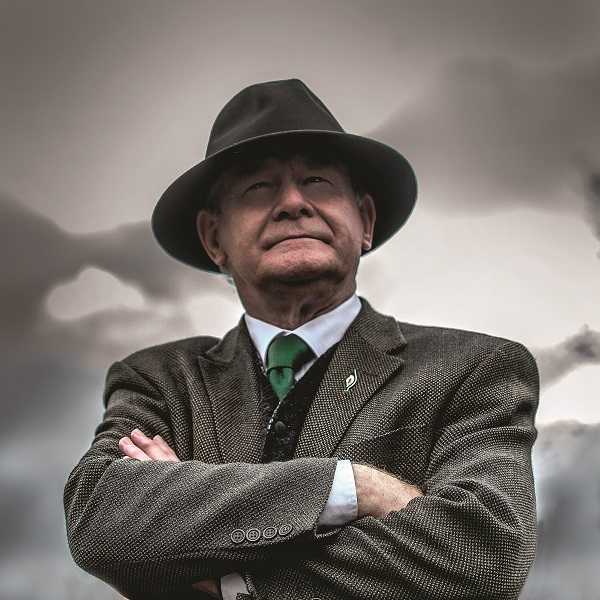
Greg’s photo of Martin McGuinness
And then there’s the ability to react to your surroundings, to recognise the potential for a fantastic shot and to take it without missing the moment. One of those moments arrived at Greg’s feet (literally) in 2016, during one of the 1916 commemorative events in Dublin’s Merrion Square. Hearing a commotion behind him, Greg turned to see Martin McGuinness and Gerry Adams in attendance, surrounded by crowds taking photos. With Adams out of reach and McGuinness close by, Greg quickly dropped to his feet and pointed the camera towards the sky. When McGuinness passed away in January 2017 the resultant shot went viral – from a profile picture for Sinn Féín’s Mary Lou McDonald on Facebook to being blown up and displayed at McGuinness’ month’s mind in New York’s St. Patrick’s Cathedral.
“I knew the shot I wanted to get when I saw him. If I had kept it at eye level you would see hundreds of people behind him,” says Greg. “It’s obviously one of those photographs I’m proud of because it has become iconic. It’s a real moment in time photograph. That’s the way I think of it.”
I ask Greg about what draws him to the streets with his camera in hand, what motivates him to seek out the candid moments that have become his signature, to stake out a location for hours in search of the perfect shot. “When I’m out taking photographs I can get lost in my own little world, I don’t think of anything else,” he says. “I think that’s what I enjoy about it. I’m in a different world when I’m taking photographs – the normal world disappears and I’m in a bit of a dreamlike state. All that I can think of is the camera, the photograph and the end result.”
Before I leave, our conversation turns once more to the time he spent with Dublin Fire Brigade – the fact that he treasures those years evident by the smile on his face and the pride in his tone. Greg singles out the comradeship in the job as one of the highlights, getting to know the individuals on your crew and how best to work with them.
“I’ve had a brilliant and varied career in DFB,” he adds. “For me, it was all about being in the right place at the right time and never refusing to take up any role that was offered to me. There was never a day that I didn’t look forward to going in.”


